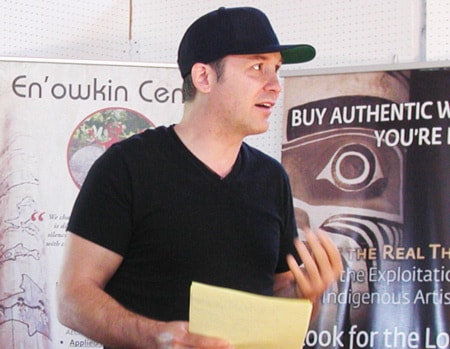A new program, sponsored by Aboriginal Tourism B.C., aims to encourage buyers to be more aware of whether the art they are buying is authentic.
Through a Authentic Indigenous trademark the buyer can be assured both that the artwork comes from an indigenous source and the artist has been fairly compensated.
But trying to answer the question “what is art?” is already a tricky proposition. Expanding the question to “what is indigenous art?” adds a whole new range of questions.
Who made this dream catcher? Was it made in China, or was it made here by an Ojibway? Or by an Okanagan? Does it matter whether it was made with traditional methods and materials, or modern materials?
Those were just a few of the points addressed at the En’owkin Centre on June 5 as artists gathered in a discussion circle to hear Shain Jackson, Coast Salish artist, lawyer, and developer of Authentic Indigenous, talk about the program.
Bare bones, it is about supplying prospective buyers with the truth, according to Jackson.
“We are connecting the consumer with the artist, and that artist’s story, biography, samples of their work,” he said. “The only thing our program does is ensures that artist is telling the truth about what they are doing.”
In a world filled with knockoffs of traditional designs, Jackson said the authentic indigenous program is needed to help protect both the artist and the buyer.
The figures are staggering. Up to 80 per cent of the indigenous-themed souvenirs and giftware items sold in B.C. have no involvement from an indigenous artist.
And while indigenous arts, crafts and gift market products contribute an estimated $10 million dollars annually to B.C’s economy, indigenous artists receive less than .01 per cent of those revenue streams.
“Who gets to say what is and isn’t authentic? You can have a Ojibway man make a dream catcher that is 100 per cent authentic. You can take the same materials to China, he continued, and is that authentic? It is not, but it is marketed as authentic,” said Bruce Manuel, a singer and a Corrections Branch liason.
But Jackson said Authentic Indigenous is already starting to address the problem.
“We have already presided over one of the biggest shifts in resources in the art market, back to our communities where they are needed most,” said Jackson. “It has been the biggest shift in control over the artwork that has ever happened.”
The Authentic Indigenous trademark may also help interior artists stand out from their coastal counterparts.
“There are so many things today in marketing that are pan-Indian. They paint us all with the same brush,” said Manuel.
“Their perception of who indigenous people are is either totem poles or dream catchers,” said Manuel. “You go back east and everything is totem poles. Out here, you go into a gift shop, there are 10,000 dream catchers hanging up.”
Neither is part of Okanagan culture, but several of the artists in the circle, which included performance artists, sculptors, beadworkers, echoed the experience of being told that work wasn’t really authentic, since it wasn’t the West Coast, particularly the Haida designs, people expect.
Authentic Indigenous is a multi-tiered branding system designed to provide the widest scope of economic and cultural protection for indigenous artwork.
Using a variety of means, Aboriginal Tourism B.C. will act to market and promote the Authentic Indigenous brand, encouraging buyers ranging from tourists to collectors and corporate buyers to use the Authentic Indigenous brand to guide their purchases.
Whenever a buyer picks up an Authentic Indigenous item they will see two things: The name of the artist whose work is being sold; and the Authentic Indigenous brand which leads the viewer to the Authentic Indigenous website.
This site houses information such as the artists’ heritage, style of art, products and related information. Instead of telling the consumer what authentic is, they are providing the information to decide if it meets their own criteria for authenticity.
“It is a loaded term in any event. The definition of authenticity we are using is ‘true to fact.’ We are not telling people what authentic is, we are bringing them the truth for them to decide for themselves,” said Jackson. “It is a very subjective term. What is authentic to me, in even coastal art, it will not be the same for someone else.”
For more information on Authentic Indigenous visit their website at www.authenticindigenous.com.
